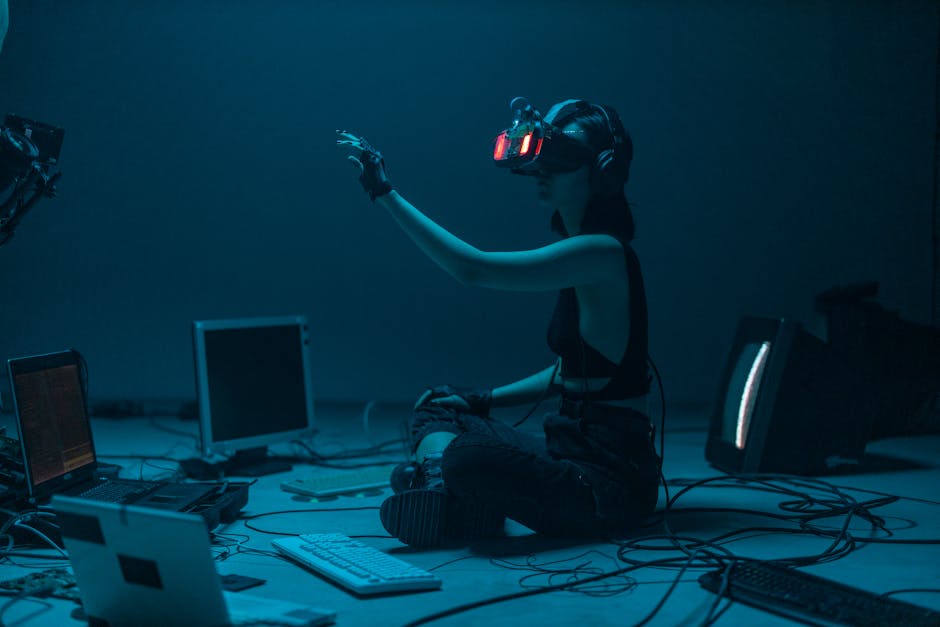Unlock Emotions in Gaming: Biometric Feedback for Deeper Engagement
The world of gaming has evolved at an astonishing pace, transforming from pixelated sprites to immersive experiences that captivate the senses. Yet, as technology advances, game developers face a daunting challenge: how to deepen player engagement and evoke genuine emotional responses. One of the most exciting frontiers in this search is the use of biometric feedback. This cutting-edge technology is changing the way players interact with games, introducing a layer of emotional connection that was once deemed impossible.
What Is Biometric Feedback in Gaming?

At its core, biometric feedback refers to the collection and analysis of physiological data—from heart rate to skin conductivity—during gameplay. These metrics provide developers with a real-time understanding of how players are feeling as they navigate their virtual worlds. Imagine playing an intense horror game and having your heart rate monitored; if it spikes during a jump scare, the game could dynamically respond to amplify the fear factor!
The Science Behind Emotions and Gaming

Understanding the science of emotions in gaming is crucial. When players are deeply engaged in a game, they experience a mix of excitement, tension, joy, and anxiety. According to a study in the journal Computers in Human Behavior, players’ physiological responses can directly correlate with their level of immersion and enjoyment. This means game developers are not just creators of virtual spaces but also architects of emotional journeys.
Incorporating biometric feedback allows for a uniquely tailored gaming experience, adapting to a player's emotional state. This method increases engagement, as players feel recognized and understood by the game itself. It creates a dialogue: while players express emotions, the game responds, deepening their connection and enhancing their overall experience.
Enhancing Player Experience Through Biometric Data

Biometric feedback adds a new dimension to game design. This technology utilizes various wearables—like smartwatches and specialized gaming peripherals—to gather data. Developers can analyze this data to fine-tune game environments, narratives, and mechanics, ensuring they resonate emotionally with players.
Dynamic Storytelling Based on Emotional Cues

Imagine a narrative-driven game that alters its storyline based on a player’s emotional state. If a player appears anxious (indicated by rapid heart rate and elevated skin conductance), the game could introduce calming elements or lighter narrative threads to balance the experience. By contrast, if a player is invigorated and focused, the game might ramp up the challenges and intensity.
This level of interaction can lead to varied gameplay experiences within the same game. Players will have the opportunity to engage in unique narratives based on their emotional reactions, offering endless replayability and personal investment in the storyline.
Tailoring Gameplay Mechanics for Engagement

Beyond narratives, biometric feedback can influence gameplay mechanics themselves. For example, a game could adjust difficulty levels based on players' stress signals or even introduce adaptive AI solutions that react to a player's emotional state. By monitoring how stressed a player is during challenging sections, designers can dynamically adjust the game’s obstacles, creating a balanced experience that feels just right for each individual.
The Benefits of Biometric Feedback in Gaming

The advantages of using biometric feedback in video gaming extend well beyond mere entertainment. For developers and designers, this technology offers an invaluable tool to enhance creativity and design strategies, leading to richer gaming experiences.
Creating Immersive Environments

Integrating biometric data allows for the crafting of environments that resonate emotionally with players. Sounds, visuals, and challenges can mold according to how players feel at any moment. Additionally, the physiological metrics can be visualized in the game, allowing players to see their emotional states compared to game events, fostering a self-awareness that enhances gameplay.
For an in-depth exploration of how sounds influence player experience, you may find this article about soundscapes and storytelling quite insightful.
Improving Player Wellbeing Through Game Design

Biometric feedback isn’t solely about creating more engaging games; it can also have a profound impact on player well-being. Understanding players’ emotional responses allows for the exploration of therapeutic applications for gaming. For example, games can be designed to promote relaxation, stress relief, and mental resilience, which is increasingly relevant in today’s fast-paced world.
More information about how gaming can enhance mental health can be found in articles about gaming mechanics in therapy, showcasing the positive effects of engaging with games through a psychological lens.
Ethical Considerations in Biometric Data Usage

While the prospects are exciting, the use of biometric feedback raises questions regarding privacy and ethical concerns. Players' physiological data is sensitive, necessitating a robust framework to protect their information and ensure that they are aware of how their data is used. Developers must adhere to strict guidelines to build trust with their audience, ensuring a transparent approach to biometric data collection.
Navigating Privacy Issues

It is essential for developers to design games that clearly articulate data usage and provide players with options regarding what data is collected. Privacy is paramount; players should have control over their personal information, and transparent policies should govern how data is stored and utilized.
Moreover, an emphasis on ethical gaming practices will foster a positive relationship between gamers and developers, which can lead to richer community engagement and trust—a must-have in today's competitive market.
Future Trends: Biometric Feedback and Virtual Reality

As technology progresses, the synergy between biometric feedback and virtual reality (VR) experiences is likely to propel gaming into entirely new dimensions. With VR, the immersion is heightened, and the integration of biometric feedback can unlock even deeper emotional experiences.
The Possibilities Within VR

Imagine a VR horror game where biometric feedback dictates the pace of the experience. Heart rate thresholds could trigger eerie sounds or visuals, keeping players on the edge of their seats. Alternatively, if a player's pulse calms, the environment could shift from a menacing atmosphere to a serene landscape. This level of immersion represents the frontier of gaming that merges physical and digital experiences, thereby enhancing emotional engagement.
The Rise of Alternative Platforms

Developers are exploring how biometric feedback might function across alternative platforms like mobile and cloud gaming. Integrating this technology into widely accessible systems could democratize advanced gaming experiences, allowing anyone with a smartphone to engage in emotionally rich gameplay.
Enhancing Player Communities Through Shared Emotions

Biometric feedback can foster a sense of community among players by enabling shared emotional experiences. Games that allow players to see or discuss their biometric data can cultivate discussions around emotions and stress, thereby reducing stigma around mental health.
Creating Collaborative Experiences

Multiplayer games can utilize aggregated biometric data to understand how groups of players respond to challenges collectively. The resulting insights can help developers fine-tune competitive or cooperative elements, making the experience resonant and emotionally engaging for entire gaming communities.
You may also find it interesting how gaming communities influence shared storytelling in the piece about community-driven game design.
Final Thoughts: The Future of Gaming Is Emotional

The fusion of biometric feedback with gaming represents an exhilarating evolution in how we experience video games. As developers continue to refine this technology, the gaming landscape will reshape, paving the way for experiences that not only entertain but also evoke genuine emotional responses. By prioritizing player engagement through the lens of emotion, the future of gaming is set to be a rich tapestry woven with individual experiences.
As we look ahead, understanding how to ethically and effectively harness these insights will be paramount. Embracing this technology holds the promise to not only entertain but foster wellness, understanding, and connection among players worldwide. The future of gaming is not just about what you play; it’s about how you feel while playing.



